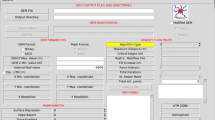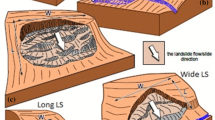Abstract
A numeric tool is presented for calculating volumes of topographic voids such as slump scars of landslides, canyons or craters (negative/concave morphology), or alternatively, bumps and hills (positive/convex morphology) by means of digital elevation models embedded within a geographical information system (GIS). In this study, it has been used to calculate landslide volumes. The basic idea is that a (singular) event (landslide, meteorite impact, volcanic eruption) has disturbed an intact surface such that it is still possible to distinguish between the former (undisturbed) landscape and the disturbance (crater, slide scar, debris avalanche). In such cases, it is possible to reconstruct the paleo-surface and to calculate the volume difference between both surfaces, thereby approximating the volume gain or loss caused by the event. I tested the approach using synthetically generated land surfaces that were created on the basis of Shuttle Radar Topography Mission data. Also, I show the application to two real cases, (1) the calculation of the volume of the Masaya Slide, a submarine landslide on the Pacific continental slope of Nicaragua, and (2) the calculation of the void of a segment of the Fish River Canyon, Namibia. The tool is provided as a script file for the free GIS GRASS. It performs with little effort, and offers a range of interpolation parameters. Testing with different sets of interpolation parameters results in a small range of uncertainty. This tool should prove useful in surface studies not exclusively on earth.




Similar content being viewed by others
References
Canals M, Lastras G, Urgeles R, Casamor JL, Mienert J, Cattaneo A, De Batist M, Haflidason H, Imbo Y, Laberg JS, Locat J, Long D, Longva O, Masson DG, Sultan N, Trincardi F, Bryn P (2004) Slope failure dynamics and impacts from seafloor and shallow sub-seafloor geophysical data: case studies from the COSTA project. Mar Geol 213(1/4):9–72
Farr TG, Rosen PA, Caro E, Crippen R, Duren R, Hensley S, Kobrick M, Paller M, Rodriguez E, Roth L, Seal D, Shaffer S, Shimada J, Umland J, Werner M, Oskin M, Burbank D, Alsdorf D (2007) The shuttle radar topography mission. Rev Geophys 45:RG2004. doi:10.1029/2005RG000183
Gee MJR, Gawthorpe RL, Friedmann SJ (2006) Triggering and evolution of a giant submarine landslide offshore Angola, revealed by 3D seismic stratigraphy and geomorphology. J Sed Res 76:9–19
Hampton MA, Lee HJ, Locat J (1996) Submarine landslides. Rev Geophys 34:33–59
Harders R, Brückmann W, Feeser V, Hensen C, Kutterolf S (2006) Ash layers: the controlling factor on translational sliding offshore Central America? AGU Fall Meeting, 11–15 December 2006, San Francisco, CA, abstract #OS43C-0666
Hühnerbach V, Masson DG (2004) Landslides in the North Atlantic and its adjacent seas: an analysis of their morphology, setting and behaviour. Mar Geol 213(1/4):343–362
Imbo Y, Batist MD, Canals M, Prieto MJ, Baraza J (2003) The Gebra slide: a submarine slide on the Trinity Peninsula Margin, Antarctica. Mar Geol 193:235–252
Kerle N (2002) Volume estimation of the 1998 flank collapse at Casita volcano, Nicaragua: a comparison of photogrammetric and conventional techniques. Earth Surf Proc Land 27(7):759–772
Lamarche G, Joanne C, Collot J-Y (2008) Successive, large mass-transport deposits in the south Kermadec fore-arc basin, New Zealand: the Matakaoa submarine instability complex. Geochem Geophys Geosyst 9:Q04001. doi:10.1029/2007GC001843
Masson DG, Harbitz CB, Wynn RB, Pedersen G, Lovholt F (2006) Submarine landslides: processes, triggers and hazard prediction. Philos Trans R Soc A Math Phys Eng Sci 364(1845):2009–2039
McAdoo BG, Pratson LF, Orange DL (2000) Submarine landslide geomorphology, US continental slope. Mar Geol 169(1/2):103–136
Mitasova H, Hofierka J (1993) Interpolation by regularized spline with tension: II. Application to terrain modeling and surface geometry analysis. Math Geol 25:657–667
Neteler M, Mitasova H (2004) Open source GIS: a GRASS GIS approach. Kluwer International Series in Engineering and Computer Science (SECS), vol 689. Boston, Kluwer
Roering JJ, Stimely LL, Mackey BH, Schmidt DA (2009) Using DInSAR, airborne LiDAR, and archival air photos to quantify landsliding and sediment transport. Geophys Res Lett 36:L19402. doi:10.1029/2009GL040374
Talukder AR, Bialas J, Kläschen D, Brückmann W, Reston TJ, Petersen CJ (2008) Tectonic framework of the mud mounds, associated BSRs and submarine landslides offshore Nicaragua Pacific margin. J Geol Soc Lond 165:167–176
Tappin DR, Watts P, McMurtry GM, Lafoy Y, Matsumoto T (2001) The Sissano, Papua New Guinea tsunami of July 1998—offshore evidence on the source mechanism. Mar Geol 175(1/4):1–23
Tsutsui K, Rokugawa S, Nakagawa H, Miyazaki S, Cheng C-T, Shiraishi T, Yang S-D (2007) Detection and volume estimation of large-scale landslides based on elevation-change analysis using DEMs extracted from high-resolution satellite stereo imagery. IEEE Trans Geosci Remote Sens 45(6):1681–1696
Urgeles R, Masson DG, Canals M, Watts AB, LeBas T (1999) Recurrent large-scale landsliding on the west flank of La Palma, Canary Islands. J Geophys Res 104(B11):25,331–25,348
Vanneste M, Mienert J, Bünz S (2006) The Hinlopen slide: a giant, submarine slope failure on the northern Svalbard Margin, Arctic Ocean. Earth Planet Sci Lett 245(1/2):373–388
Watts P, Grilli ST, Tappin DR, Fryer GJ (2005) Tsunami generation by submarine mass failure. II. Predictive equations and case studies. J Waterway Port Coastal Ocean Eng 131(6):298–310
Wessel P, Smith WHF (1998) New, improved version of the generic mapping tools released. EOS Trans AGU 79:579
Winkelmann DW, Jokat W, Niessen F, Stein R, Winkler A (2006) Age and extent of the Yermak Slide north of Spitsbergen, Arctic Ocean. Geochem Geophys Geosyst 7:Q06007. doi:10.1029/2005GC001130
Acknowledgements
This publication is contribution no. 178 of the Sonderforschungsbereich 574 “Volatiles and Fluids in Subduction Zones” at Kiel University. I am grateful for comments and corrections by R. Urgeles and M.T. Delafontaine.
Author information
Authors and Affiliations
Corresponding author
Electronic supplementary material
Below is the link to the electronic supplementary material.
ESM 1
(PDF 10882 kb)
These files are unfortunately not in the Publisher's archive anymore:
-
ESM 2 (GRD 158 kb)
-
ESM 3 (GRD 981 kb)
-
ESM 4 (GRD 72 kb)
-
ESM 5 (GRD 271 kb)
-
ESM 6 (GRASS 30 kb)
Rights and permissions
About this article
Cite this article
Völker, D.J. A simple and efficient GIS tool for volume calculations of submarine landslides. Geo-Mar Lett 30, 541–547 (2010). https://doi.org/10.1007/s00367-009-0176-0
Received:
Accepted:
Published:
Issue Date:
DOI: https://doi.org/10.1007/s00367-009-0176-0




